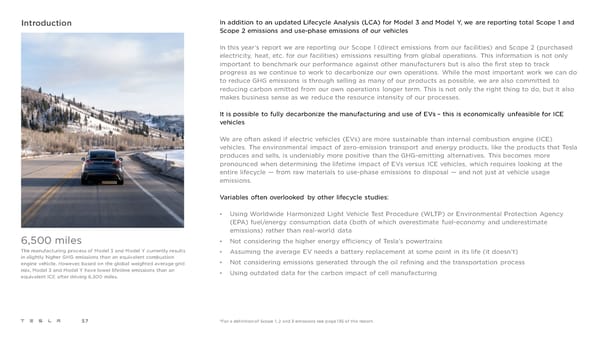Introduction In addition to an updated Lifecycle Analysis (LCA) for Model 3 and Model Y, we are reporting total Scope 1 and Scope 2 emissions and use-phase emissions of our vehicles In this year’s report we are reporting our Scope 1 (direct emissions from our facilities) and Scope 2 (purchased electricity, heat, etc. for our facilities) emissions resulting from global operations. This information is not only important to benchmark our performance against other manufacturers but is also the first step to track progress as we continue to work to decarbonize our own operations. While the most important work we can do to reduce GHG emissions is through selling as many of our products as possible, we are also committed to reducing carbon emitted from our own operations longer term. This is not only the right thing to do, but it also makes business sense as we reduce the resource intensity of our processes. It is possible to fully decarbonize the manufacturing and use of EVs – this is economically unfeasible for ICE vehicles We are often asked if electric vehicles (EVs) are more sustainable than internal combustion engine (ICE) vehicles. The environmental impact of zero-emission transport and energy products, like the products that Tesla produces and sells, is undeniably more positive than the GHG-emitting alternatives. This becomes more pronounced when determining the lifetime impact of EVs versus ICE vehicles, which requires looking at the entire lifecycle — from raw materials to use-phase emissions to disposal — and not just at vehicle usage emissions. Variables often overlooked by other lifecycle studies: • Using Worldwide Harmonized Light Vehicle Test Procedure (WLTP) or Environmental Protection Agency (EPA) fuel/energy consumption data (both of which overestimate fuel-economy and underestimate emissions) rather than real-world data 6,500 miles • Not considering the higher energy efficiency of Tesla’s powertrains The manufacturing process of Model 3 and Model Y currently results • Assuming the average EV needs a battery replacement at some point in its life (it doesn’t) in slightly higher GHG emissions than an equivalent combustion • Not considering emissions generated through the oil refining and the transportation process engine vehicle. However, based on the global weighted average grid mix, Model 3 and Model Y have lower lifetime emissions than an • Using outdated data for the carbon impact of cell manufacturing equivalent ICE after driving 6,500 miles. 57 *For a definition of Scope 1, 2 and 3 emissions see page 135 of this report.
 Tesla 2021 Impact Report Page 56 Page 58
Tesla 2021 Impact Report Page 56 Page 58